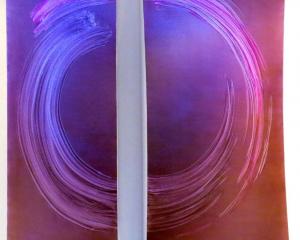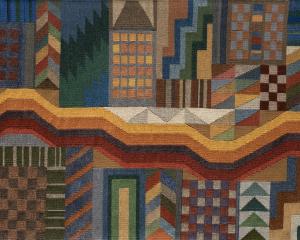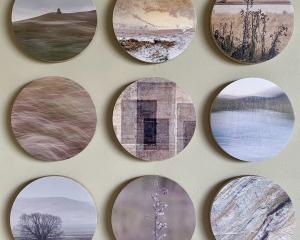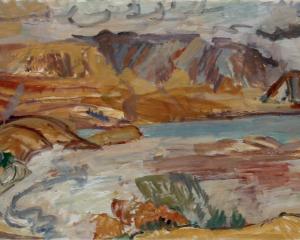''Gold Town II'', Rachel Hirabayashi (Hullabaloo Art Space, Cromwell)
Miners and their families clung to the dream of prosperity in small communities under conditions of stress and adversity, establishing scattered pockets of civilisation in a remote and difficult environment. Around the region today, ruins and remnants attest to the isolation. Yet miles from roads, amenities and acquaintances, people still erected picket fences and gardens, built churches and schools, and got on with the business of life.
The widely spaced buildings in all the paintings of ''Gold Town II'' emphasise the loneliness, but the simple beauty of the haloed church in Woman with Dogs affirms the faith and courage of the settlers. Hirabayashi's style combines an elegant simplicity of form with a moody, atmospheric treatment of surrounding landscape and weather.
Buildings are depicted with a starkness that contrasts well with the earthy palette of land and sky. Gold Town Scape I is particularly appealing, a valiant dotting of dwellings under an overcast sky, the tones evocative of a dry, dusty heat.
The metalwork sculptures are equally effective. In simple welded lines, a general store, a hotel and a school form a doll's house set for historians, like paper sketches brought to three-dimensional life.
''Recent Works'', Deidre Copeland (The Nose, Cromwell)
The superiority of her brushwork is self-evident - a number of her pieces are almost jaw-droppingly good - but they are not simply a photographic reproduction of the subject. With every work, there is a sense Copeland is inspired by the personality that exists behind the planes of the face, the pores of the skin and the lights in the eyes.
These are individuals with a history and stories to tell, not merely collections of interesting lines, angles and textures. There is a beauty and attraction to every painted face, not in spite of but because of wrinkles, crinkles, tears and grimaces, the signs of life and individuality Copeland paints with such care.
Appropriately, given their display in a restaurant in wine country, many of the new works depict people with drinks in hand, as well as the slightly tongue-in-cheek Teetotaller,
who holds his empty glass upside down with a resigned expression. Copeland's signature mastery of a troublesome subject, the human hand, is on display in Water to Wine, where the delicate matte texture of the fingernails contrasts with the brittle shine of the assembled wineglasses, while a careful application of gold and silver leaf illuminates pieces like Precious Metal and Stone.
''What the Layers Reveal'', Jenny Hill (Carrick Winery, Bannockburn)
The works incorporate pieces of maps, canvas, printed fabrics, photographic collage and thick impasto paint to create images that tell a cohesive story yet encourage close examination of each component. The scenes move from sky through hills and livestock, water and earth, making clever use of a certain element of abstraction without impairing the effect of the narrative.
The second series of works focus on Williams Cottage, Queenstown's oldest remaining house, built in 1864 and eventually made an annexe of the Lakes District Museum & Gallery. The cottage is renowned for its retention of original wallpapers, and Hill uses printed blocks to reproduce the antique patterns, weaving in photographs, letters and documentation of the original family and surroundings.
Mary Williams I is rather wonderful, the reproductions overlaid with layers of paint and materials that mimic the appearance of schist and earth, as if a historical scrapbook has slowly been exposed to and reclaimed by the Central landscape. Hill's work is thoughtful and intelligent, demanding a response from the viewer and demonstrating the interest of the artist in her subject.
- Laura Elliot












